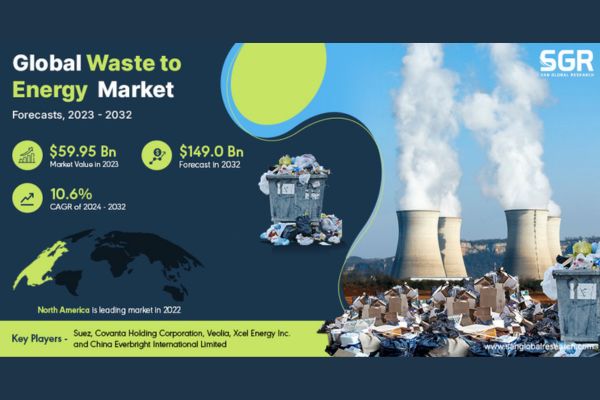According to the new report titled “ Waste to Energy Market by By Technology {Biological (Microbial Fuel Cells, Algae Biotechnology, Fermentation, Biogas Plants, Anaerobic Digestion, Hydrolysis and Landfill Gas Collection) Thermal (Pyrolysis, Thermal Gasification, Combustion/Incineration, Hydrothermal Carbonization) and ( Others)}, By Type {Organic, Agro-Industrial, Livestock, Municipal Solid, Sewage, Landfill and Plastic}, By Application {Biogas, Electric, Biogas Electric Generation, Biofuel and Hydrogen} Global Analysis to 2023″, the valuation of the Waste to Energy Market was $59.95 Billion in 2023 and is projected to reach $149.0 Billion by 2032, at a CAGR of 10.6% from 2024 to 2032.
The production of essential products necessitates energy, and the constant rise in energy demand is driven by factors such as a growing population, technological advancements, and economic development. In developing countries, the energy sector contributes to almost 90% of CO2 emissions and 75% of total greenhouse gas (GHG) emissions. Notably, half of these emissions arise from the combustion of fossil fuels in power plants and refineries. In developed countries, major greenhouse gas emitters include energy producers and agriculture, accounting for 25.9% and 13.5% of global annual emissions, respectively. The waste triangle encompasses pollutants, greenhouse gases, and plastics. Hydrocarbons found in domestic waste can be converted into electricity through thermoelectric and anaerobic digestion plants, albeit resulting in the production of pollutants and greenhouse gases. Moreover, damaged roads and building infrastructures hold potential for conversion into usable heat energy storage materials. The transformation of waste into watts, energy, and value-added products, such as chemicals, emerges as a pathway for long-term sustainability. Promising reports underscore noteworthy advancements in transforming pollutants into hydrogen, converting green gases into sustainable energy, repurposing biomass into biofuels, and utilizing plastics for building materials. The imperative shift towards circular economies becomes evident for fostering sustainable development, steering away from linear models characterized by the take, make, use, dispose, and pollute paradigm. In contrast, a sustainable circular economy champions the principles of taking, making, using, reusing, and recycling.
Thermal based Technology to held the largest share in the Waste to Energy Market.
By Technology, the Waste to Energy Market is segmented into Pyrolysis, Thermal Gasification, Combustion/Incineration and Hydrothermal Carbonization.
For the reasons mentioned earlier, there is a rising interest in the waste-to-energy (WtE) sector. Incineration has traditionally been the dominant WtE technology, with over 1400 incineration plants in operation worldwide. Nevertheless, the latest generation of municipal solid waste (MSW) incinerators encounters limitations, with electricity efficiency peaking at around 22–25%. This restriction stems from the boiler’s maximum steam temperature, usually kept below 450 °C to prevent corrosion caused by gaseous HCl. Lately there is a surge in innovative technologies such as the pyrolysis and gasification, in the field of Waste to Energy sector. Due to adaptation of such technologies, there has been increase in energy efficiency and also being eco-friendly. While modern incinerators can meet environmental standards. These methods offer the potential to generate a syngas suitable for diverse applications. Concerning the energetic utilization in WtE plants, there is a widely held perception that pyrolysis and gasification could achieve higher efficiency by supplying the syngas to more efficient energy conversion devices, such as a gas turbine/combined cycle (gas turbine/CC) or an internal combustion engine. As a result, due to the outlined factors, the thermal segment is leading in the waste-to-energy landscape.
North America to be at the front in 2023, leading the Waste to Energy Market.
North America is emerged as leading market for Waste to Energy market in 2023. North America stands to benefit significantly from its robust presence in leading adoption of technology. The prominence of the North American Waste-to-Energy market is closely tied to the repercussions of urbanization, correlating with a surge in waste generation attributed to heightened population density and evolving consumption patterns. As urban areas expand and populations concentrate, there is a notable uptick in the volume of generated waste. Currently, 75 facilities in the United States are dedicated to recovering energy through the combustion of municipal solid waste, predominantly situated in 25 states, particularly in the Northeast. Notably, a new facility was erected in Palm Beach County, Florida, in 2015. The thermal segment takes the lead, with a typical waste-to-energy plant generating approximately 550 kilowatt-hours (kWh) of energy per ton of waste. At an average price of four cents per kWh, revenues per ton of solid waste often range from 20 to 30 dollars, contributing to the booming growth of the waste-to-energy market in the North American region.
Key market players operating in the market that are profiled in the report are Suez, Covanta Holding Corporation, Veolia, Xcel Energy Inc. and China Everbright International Limited etc.















